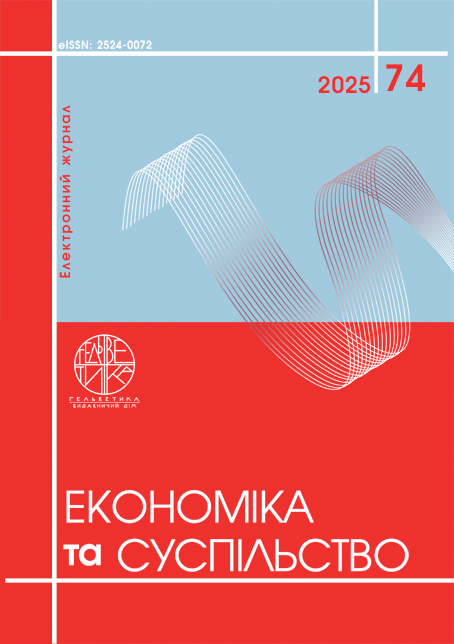ANALYSIS OF SOFTWARE PLATFORMS FOR CREATING DIGITAL TWINS IN ECONOMIC SECTORS
Abstract
The article explores the landscape of software solutions for creating digital twins—virtual models of physical objects or processes that are essential in modern industries, including manufacturing, energy, transportation, and healthcare. The authors discuss challenges such as the absence of standardized frameworks, the complexity of integrating heterogeneous data sources, and scalability limitations affecting deployment. Through an analysis of scientific publications (IEEE Xplore, ScienceDirect), technical reports (Gartner, IBM), and industrial case studies (2020–2024), the article proposes a classification of technological approaches to digital twin development, covering physics-based, data-driven, hybrid, and cloud-edge models. A comparative study of leading platforms (Siemens Digital Industries, Azure Digital Twins, PTC ThingWorx, Ansys Twin Builder, among others) evaluates key criteria, including functionality, interoperability, computational performance, security mechanisms, and total cost of ownership. To facilitate objective software selection, the study introduces a weighted evaluation methodology, which is tested in the energy sector, providing insights into practical adoption strategies. The findings suggest that Azure Digital Twins excels in cloud security and integration, while Siemens MindSphere is well-suited for industrial applications, whereas domain-specific tools like Autodesk Revit demonstrate restricted flexibility. The conclusions provide strategic recommendations for implementing digital twins, emphasizing the need for a combined edge-cloud computing approach, the adoption of zero-trust security frameworks, and the application of AutoML for model adaptation and optimization. Additionally, the study outlines future trends, including the standardization of protocols (OPC UA, ISO 23247), the emergence of DTaaS (Digital Twin as a Service) solutions, and the advancement of 5G/TSN networks for real-time simulations. Ultimately, the article underscores the importance of tailoring platform selection to industry requirements, technical constraints, and financial considerations to ensure optimal digital twin deployment across various sectors.
References
Digital Twins and Parallel Intelligence (DTPI), IEEE International Conference on URL: https://ieeexplore.ieee.org/xpl/conhome/10778636/proceeding (дата звернення: 29.04.2025).
Emerging Tech: Revenue Opportunity Projection of Simulation Digital Twins. URL: https://www.gartner.com/en/documents/5451563 (дата звернення: 29.04.2025).
Chen Y., Wang S. He, B., Duan P., Zhang B., Hong Z., and Ping Y., Crypt-analysis and improvement of DeepPAR: Privacy-preserving and asynchronous deep learning for industrial IoT. IEEE Internet Things J. 2022. №. 9(21). pp. 21958–21970.
Tao, F., Zhang, C., Qi, Q., Zhang, H. Digital twin maturity model. Computer Integrated Manufacturing Systems. 2022. №28. рр. 1267-1281.
Ismail M, Amal Abdel Gawad. Revisiting zero-trust security for internet of things. Sustainable Machine Intelligence Journal. 2023. №3(6). pp 1-8.
Adamenko Dmytro, Kunnen Steffen, Nagarajah Arun. Comparative analysis of platforms for designing a digital twin. Advances in Design, Simulation and Manufacturing III: Proceedings of the 3rd International Conference on Design, Simulation, Manufacturing (Kharkiv, June 9-12, 2020). Kharkiv: Springer International Publishing, 2020. pp. 3-12.
Jafari Mina, Abdollah Kavousi-Fard, et al. A review on digital twin technology in smart grid, transportation system and smart city: Challenges and future. IEEE Access. 2023. №11. pp. 17471-17484.
Wang Yuntao, et al. A survey on digital twins: Architecture, enabling technologies, security and privacy, and future prospects. IEEE Internet of Things Journal. 2023, №10(17). pp. 14965-14987.
Foundational Research Gaps and Future Directions for Digital Twins. URL: https://www.ncbi.nlm.nih.gov/books/NBK605512/ (дата звернення: 12.04.2025).
Kamran Iranshahi, Joshua Brun, Tim Arnold, Thomas Sergi, Ulf Christian Müller. Digital twins: Recent advances and future directions in engineering fields. Intelligent Systems with Applications. 2025. №26. URL: https://doi.org/10.1016/j.iswa.2025.200516 (дата звернення: 20.04.2025).
Muctadir, H.M., Manrique Negrin, D.A., Gunasekaran, R. et al. Current trends in digital twin development, maintenance, and operation: an interview study. Software and Systems Modeling. 2024. №23. pp. 1275–1305. URL: https://doi.org/10.1007/s10270-024-01167-z (дата звернення: 21.04.2025).
Digital Twins and Parallel Intelligence (DTPI), IEEE International Conference on. Available at: https://ieeexplore.ieee.org/xpl/conhome/ 10778636/proceeding (accessed April 29, 2025).
Emerging Tech: Revenue Opportunity Projection of Simulation Digital Twins. Available at: https://www.gartner.com/en/documents/5451563 (accessed April 29, 2025).
Chen Y., Wang S. He, B., Duan P., Zhang B., Hong Z., and Ping Y. (2022) Crypt-analysis and improvement of DeepPAR: Privacy-preserving and asynchronous deep learning for industrial IoT. IEEE Internet Things J. 2022. vol. 9(21), pp. 21958–21970.
Tao F., Zhang C.Y., Qi, Q.L. and Zhang H. (2022) Digital twin maturity model. Computer Integrated Manufacturing Systems, vol. 28, рр. 1267-1281.
Ismail M, Amal Abdel Gawad. (2023) Revisiting zero-trust security for internet of things. Sustainable Machine Intelligence Journal, vol. 3(6), pp 1-8.
Adamenko Dmytro, Kunnen Steffen, Nagarajah Arun. (2020) Comparative analysis of platforms for designing a digital twin. Advances in Design, Simulation and Manufacturing III: Proceedings of the 3rd International Conference on Design, Simulation, Manufacturing (Kharkiv, June 9-12, 2020). Kharkiv: Springer International Publishing, pp. 3-12.
Jafari Mina, Abdollah Kavousi-Fard, et al. (2023) A review on digital twin technology in smart grid, transportation system and smart city: Challenges and future. IEEE Access, vol. 11, pp. 17471-17484.
Wang Yuntao, et al. (2023) A survey on digital twins: Architecture, enabling technologies, security and privacy, and future prospects. IEEE Internet of Things Journal, vol. 10(17), pp. 14965-14987.
Foundational Research Gaps and Future Directions for Digital Twins. Available at: https://www.ncbi.nlm.nih.gov/books/NBK605512/ (accessed April 12, 2025).
Kamran Iranshahi, Joshua Brun, Tim Arnold, Thomas Sergi, Ulf Christian Müller. (2025) Digital twins: Recent advances and future directions in engineering fields. Intelligent Systems with Applications, vol. 26. Available at: https://doi.org/10.1016/j.iswa.2025.200516 (accessed April 20, 2025)
Muctadir, H.M., Manrique Negrin, D.A., Gunasekaran, R. et al. (2024) Current trends in digital twin development, maintenance, and operation: an interview study. Software and Systems Modeling, vol. 23, pp. 1275–1305. Available at: https://doi.org/10.1007/s10270-024-01167-z (accessed April 21, 2025).

This work is licensed under a Creative Commons Attribution 4.0 International License.


